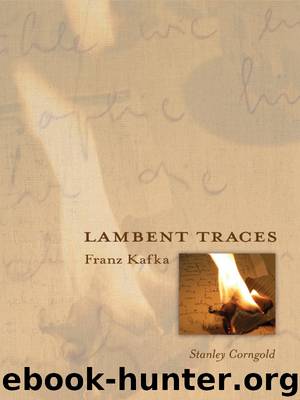Lambent Traces by Corngold Stanley;

Author:Corngold, Stanley;
Language: eng
Format: epub
Publisher: Princeton University Press
Published: 2008-03-24T04:00:00+00:00
A PROSPECT AT MIDPOINT
Read in a totalizing way, the form of the wish displays qualities of the worldview that the wish means to attain as its content (as something bold and simultaneously nothing at all). This reading fuses together both subjective and objective senses of the “wish.” But one can also stress the distinction between them, reading the “full-bodied rise and fall” of life as the manifest content masking the latent content of the wish-which remains, irreducibly, a certain manner of wishing (read: a certain manner of writing). Finally, according to a third way of reading, it is this writing itself that acquires an absolute distinction apart from any kind of writing that might correspond to the being or making of the object it has in view. Here, “writing” means the gerund of the intransitive verb “to write”-writing as a state of being, for which Kafka has the word Schriftstellersein.
This moving quadrilateral of nature/nothing; construction/nothing in the field of writing is Kafka’s signature of what I am calling an aesthetics of skepticism. It would come about in Kafka’s writing through the semblance of representing-with maximum technical efficiency-a subject matter that displays-with a maximum of naturalness-a rise and dying fall (that is at the same time a nothing, a dream, a dim hovering). It is a high modern aesthetic, and in its elementary structure, a brother of Nietzsche’s tragic aesthetic of the resuscitated Dionysian,with the sharpest agonistic dimension subtracted. No doubt it remains discussable whether, without the agonistic side, the co-presence of the components of life and nothing and hammering and the dream and a natural rise and fall can qualify this aesthetics as Dionysian after Nietzsche. But this consideration finally, and significantly, falls away because, in Kafka’s fable, a Euripidean affect of irony, an impotence of social origin, comes at the end to disrupt this aesthetic from its basis in the strong wish, in the strong thrust of fiction. The passage concludes:
But he could not wish in this fashion; for his wish was not a wish, but only a vindication of nothingness, a justification of non-entity [better: a granting to Nothing of protection and dwelling rights (eine Verteidigung, eine Verbü rgerlichung des Nichts)], a touch of animation [better: an air of gaiety (ein Hauch von Munterkeit)], which he wanted to lend to non-entity [Nothing (das Nichts)], in which at that time he had scarcely taken his first few conscious steps, but which he already felt as his element.12 It was a sort of farewell that he took from the illusive world of youth; although youth had never directly deceived him, but only caused him to be deceived by the utterances of all the authorities he had around him.So is explained the necessity of his “wish.” (GrW 267-68, GW 11:179-80)
I will say one more word about the constructive and destructive sides of the aesthetics of skepticism and the social origin of the poorly wished wish.
Bernd Hü ppauf has written suggestively of an aesthetics of skepticism as an “aesthetics of destruction.”13 His
Download
This site does not store any files on its server. We only index and link to content provided by other sites. Please contact the content providers to delete copyright contents if any and email us, we'll remove relevant links or contents immediately.
4 3 2 1: A Novel by Paul Auster(11794)
The handmaid's tale by Margaret Atwood(7455)
Giovanni's Room by James Baldwin(6814)
Big Magic: Creative Living Beyond Fear by Elizabeth Gilbert(5359)
Asking the Right Questions: A Guide to Critical Thinking by M. Neil Browne & Stuart M. Keeley(5358)
Ego Is the Enemy by Ryan Holiday(4960)
On Writing A Memoir of the Craft by Stephen King(4667)
The Body: A Guide for Occupants by Bill Bryson(4587)
Ken Follett - World without end by Ken Follett(4448)
Bluets by Maggie Nelson(4263)
Adulting by Kelly Williams Brown(4236)
Eat That Frog! by Brian Tracy(4153)
Guilty Pleasures by Laurell K Hamilton(4120)
White Noise - A Novel by Don DeLillo(3832)
The Poetry of Pablo Neruda by Pablo Neruda(3819)
Fingerprints of the Gods by Graham Hancock(3740)
Alive: The Story of the Andes Survivors by Piers Paul Read(3731)
The Book of Joy by Dalai Lama(3700)
The Bookshop by Penelope Fitzgerald(3621)
